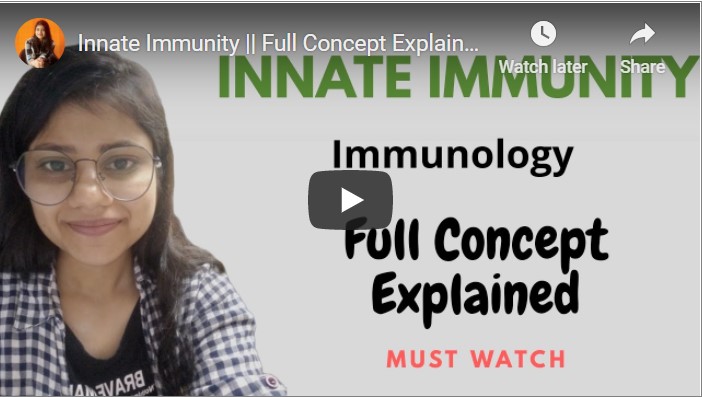In our daily life, we are exposed to millions or trillions of pathogens, through contact, inhalation, or ingestion. We got an ability to avoid infection and this is the function of our immune system. This ability to resist infections is known as immunity. Immunity is interconnected in two systems:
- 1. Innate immunity
- 2. Adaptive immunity
The concept of adaptive immunity is creating a memory of a previous pathogen that enters in body and to prepare the immune system for a specific type of pathogen when they try to attack again. However Adaptive immune responses are slow to develop on the first revelation of a new pathogen. It may take up to 1 week to create the memory and prepare for the next attack of the pathogen. Therefore, during the first exposure of a new pathogen, we must depend on our innate immune system for protecting us from infections.
In this article we are going to discuss innate immunity later we will discuss Adaptive immunity.
Every person has innate immunity by birth, but it needs an antigen exposure to gain adaptive immunity.
What is Innate immunity?
Innate immunity is the first line of defense and encoded in the germline.
BARRIERS:
The innate immune system is the nonspecific defense mechanism and response immediately or withing hours when an antigen is exposed to our body. These mechanisms also include physical and chemical barriers for the infections. Physical barriers for a pathogen are skin, hairs, etc. and chemical barriers include tears, sweat, mucous, saliva, etc.
Non-specific:
Innate immune responses aren’t specific for a pathogen while adaptive immune responses are specific. They depend on phagocytic cells which recognize conserved features of pathogens and respond quickly to destroy intruders.
The nonspecific term here means anything that is recognized as a foreign or non-self is the target of the innate response. The self and non-self cells are recognized by PRR (pattern recognition receptor).
COMPLEMENT SYSTEM
The complement system is also known as complement cascade. It is a mechanism that complements the features of the immune response. It is a part of the immune system that works with the innate immune system also can work with the adaptive immune system if needed. In the complement system, there is a variety of proteins that are circulated in the blood which are inactivated. When these proteins get activated and this will initiate the complement cascade.
The complement system proteins are mainly made by the liver and circulated in the blood. The complement system is triggered by an infection. There are three sets of the complement system:
- Classical pathway
- Lectin pathway
- Alternative pathway
These are the early complement components and all three pathways act locally to activate the C3. C3 is the pivotal component of the complement system. In humans, C3 is encoded on chromosome 19.
If you are having a deficiency of C3 thana you may have repeated bacterial infections. Later on, we are going to discuss each of these pathways in depth.
TLR (Toll-like protein receptors)
TLR is the PRR that recognizes PAMP(pathogen-associated molecular pattern). There are 10 TLR presents in humans.
TLR is named from the protein coded via the Toll gene which was 1st identified in Drosophila by Christiane Nusslein–Volgard and Eric–Wieschaus in 1985. Drosophila toll is a transmembrane protein having a large extracellular domain consisting of a series of leucine-rich repeats.
How innate immunity works?
The basic mechanism of innate immunity is via phagocytosis. Phagocytic cells search for pathogens, engulf, and destroy the pathogen. In our immune system phagocytotic cells are:
- Macrophages
- Neutrophils
- Dendritic cells
- Monocytes
In vertebrates’ macrophages exist in tissues from where infections are likely to occur, it also includes lungs and gut. Macrophages are also present in connective tissues, spleen, and liver in large numbers. Macrophages and neutrophils have a variety of surface receptors that helps them to recognize and engulf foreign particles (pathogens). Neutrophils have a short life span, and these are not found in healthy tissue. Macrophages will recruit neutrophils in the infection area. That’s the reason for the swelling or redness in the area of infection.
Once the pathogen has been phagocytosed, macrophage and neutrophil start their actions and make phagosome. After that phagosome is acidified and fused with the lysosome (phagolysosome), that contain acid hydrolases that can degrade bacterial membrane proteins. Lysosomes also contain defensins. Defensins make 15% of the total in neutrophils.
NADPH oxidase complex is recruited on the phagosomal membrane and it catalyzes the production of highly toxic O2-derived compounds such as superoxide, hydrogen peroxide, hydroxyl radicals, hypo-chloride, and nitric oxide. The production of these toxins is accompanied by a temporary increase in O2 consumption by the cell, this is known as respiratory burst.
Summary
- Innate immunity is the first line of defense against invaders.
- Innate immunity includes barriers such as chemical and physical barriers.
- Innate immunity is non-specific.
- The invaders are recognized by PRR and TLR.
- The pathogens are phagocytosed by macrophage and neutrophils.
REFERENCES:
- Alberts, B., Johnson, A., Lewis, J., Raff, M., Roberts, K., & Walter, P. (2002). Integrins. In Molecular Biology of the Cell. 4th edition. Garland Science.
- Kindt, T. J., Goldsby, R. A., Osborne, B. A., & Kuby, J. (2007). Kuby immunology. Macmillan.
- Coico, R., & Sunshine, G. (2015). Immunology: a short course. John Wiley & Sons.